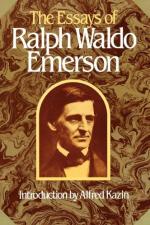[Footnote 689: Begin where we will, etc. Explain what Emerson means by this expression.]
CIRCLES
[Footnote 690: This essay first appeared in the first series of Essays, published in 1841. Unlike most of the other essays in the volume, no earlier form of it exists, and it was probably not delivered first as a lecture.
Dr. Richard Garnett says in his Life of Emerson: “The object of this fine essay quaintly entitled Circles is to reconcile this rigidity of unalterable law with the fact of human progress. Compensation illustrates one property of a circle, which always returns to the point where it began, but it is no less true that around every circle another can be drawn.... Emerson followed his own counsel; he always keeps a reserve of power. His theory of Circles reappears without the least verbal indebtedness to himself in the splendid essay on Love.”]
[Footnote 691: St. Augustine. A celebrated father of the Latin church, who flourished in the fourth century. His most famous work is his Confessions, an autobiographical volume of religious meditations.]
[Footnote 692: Another dawn risen on mid-noon. “Another morn has risen on mid-noon.” Milton, Paradise Lost, Book V.]
[Footnote 693: Greek sculpture. The greatest development of the art of sculpture that the world has ever known was that which took place in Greece, with Athens as the center, in the fifth century before Christ. The masterpieces which remain are the models on which modern art formed itself.]
[Footnote 694: Greek letters. In literature—in drama, philosophy and history—Greece attained an excellence as signal as in art. Emerson as a scholar, felt that the literature of Greece was more permanent than its art. Would an artist be apt to take this view?]
[Footnote 695: New arts destroy the old, etc. Tell the ways in which the improvements and inventions mentioned by Emerson have been superseded by others; give the reasons. Mention other similar cases of more recent date.]
[Footnote 696: The life of man is a self-evolving circle, etc. “Throw a stone into the stream, and the circles that propagate themselves are the beautiful type of all influence.”—EMERSON, in Nature.]
[Footnote 697: The heart refuses to be imprisoned. It is a superstition current in many countries that an evil spirit cannot escape from a circle drawn round it.]
[Footnote 698: Crass. Gross; coarse.]
[Footnote 699: The continual effort to raise himself above himself, etc.
“Unless above himself he
can
Erect himself, how poor a thing is man!”
SAMUEL DANIEL.
]
[Footnote 700: If he were high enough, etc.
Have I a lover
Who is noble and free?—
I would he were nobler
Than to love me.—EMERSON, The Sphinx.




